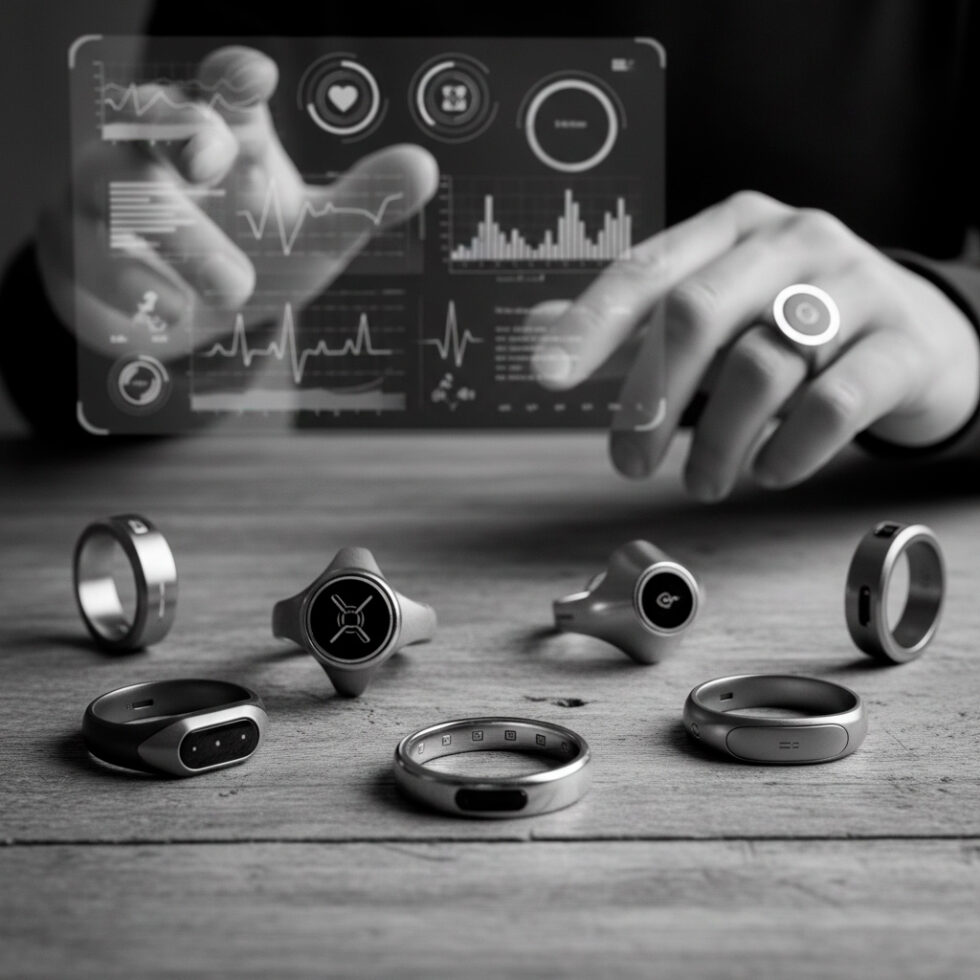
Smart rings have moved from novelty to everyday tool. They promise sleep insights, quiet health tracking, and all-day comfort without a screen on your wrist. Yet the tiny form factor forces hard trade‑offs in sensors, battery life, accuracy, and comfort. If you’re curious about what a ring can do and how to pick the right one, this deep guide is for you.
What a Smart Ring Actually Measures
Most rings focus on recovery and wellness. The core idea is simple: use optical, thermal, and motion sensors to turn your finger’s subtle signals into practical metrics you can use daily.
Heart and Vessels: PPG for Heart Rate and HRV
Photoplethysmography (PPG) uses LEDs and a light sensor to read changes in blood volume with each heartbeat. Rings typically shine green or infrared light into the skin and measure what reflects back. From that waveform, they compute:
- Heart Rate (HR): beats per minute at rest and during sleep.
- Heart Rate Variability (HRV): often the rMSSD metric, a time-domain measure linked to recovery and stress balance.
- Respiratory Rate: estimated indirectly from small oscillations in the PPG signal.
Why the finger? The arteries in your finger often provide a cleaner signal than the wrist at rest, which is why rings do well overnight. During intense motion, any PPG struggles, and rings are no exception.
Technical notes
- Wavelengths: Green light is great for heart rate during movement; infrared penetrates deeper and can help with sleep signals.
- Sampling and Duty Cycle: Rings don’t sample continuously at high rates; they schedule bursts to conserve power, especially during the day.
Temperature: Trends, Not Thermometers
Rings include a skin temperature sensor. It doesn’t show core body temperature, but can detect trends and deviations. Those patterns help flag recovery dips, jet lag, or cycle-related changes.
Look for terms like “relative temperature” or “baseline deviation.” The absolute number matters less than how it moves over days and weeks.
Motion: IMU for Movement and Sleep
An inertial measurement unit (IMU), usually a 3‑axis accelerometer, tracks motion. Rings use it to estimate steps, sleep timing, and stillness. Coupled with PPG and temperature, it helps distinguish between light sleep, deep sleep, and wakefulness.
EDA and NFC: Extras You’ll Sometimes See
Some rings add electrodermal activity (EDA) sensors to infer changes linked to stress or arousal. A few include NFC hardware for contactless access or payments. These features are less common than PPG, temperature, and motion.
Accuracy in the Real World: What Rings Do Well (and What They Don’t)
Accuracy depends on sensor quality, fit, and algorithms. Here’s where rings generally shine—and where they have limits.
Sleep and Recovery
Rings are strong at estimating bedtime, wake time, total sleep duration, and general sleep continuity. For sleep staging (light vs. deep vs. REM), their estimates track overall patterns but won’t beat clinical polysomnography. Use sleep stages as trends rather than definitive labels.
For recovery, HRV (often rMSSD), resting heart rate, body temperature trends, and sleep continuity combine into a readiness or recovery score. The score simplifies complex physiology into a daily “how hard should I go?” suggestion. Treat it as guidance, not a mandate.
Heart Rate and HRV
At rest and during sleep, rings can provide stable heart rate and HRV readings. Movement introduces artifacts, especially for HRV. If your goal is training-zone heart rate during exercise, a chest strap or high-quality watch may be more reliable. For overnight HRV, rings do well because you’re not moving much and perfusion in the fingers is good.
SpO2 and Skin Tone Considerations
Some rings estimate blood oxygen saturation (SpO2). It can be directionally useful but is sensitive to fit, perfusion, skin tone, and motion. If you require clinical accuracy, use a certified medical device. For everyday wellness, view ring-based SpO2 as “good enough to flag trends,” not a diagnostic.
Stress and EDA
EDA reflects changes in sweat gland activity modulated by the autonomic nervous system. It responds to many things: heat, exercise, caffeine, emotions. Rings can detect shifts and help you notice patterns, but stress is not a single number. Consider EDA one clue among many.
Fit, Finger Choice, and Handedness
A ring that’s too loose lets in light and motion artifacts; too tight reduces blood flow. Many brands ship a sizing kit—use it, and wear the sample for a day. Index and middle fingers often provide strong signals with less knuckle flexion than the ring finger. Try both hands; comfort matters.
Power, Radios, and Charging: What to Expect
Battery life is a core reason people choose rings. No screen means low power draw, but the battery is tiny. Smart choices by the device and the wearer make a big difference.
Battery Capacity and Life
Typical ring batteries are in the tens of milliamp-hours. Most last several days per charge with 24/7 wear. Features that consume more power:
- High-frequency PPG sampling during workouts.
- All-day SpO2 estimates (if supported).
- Frequent Bluetooth syncs and notifications.
Charging usually takes 60–120 minutes on a cradle. Some rings use pogo pins; others use inductive charging. A dry, clean interface prevents corrosion and improves reliability.
Bluetooth Low Energy
Rings communicate via Bluetooth Low Energy (BLE). It’s optimized for short bursts rather than constant streams, which is why syncs occur in sessions. You might see delayed updates if you keep the app closed for long periods.
Battery Care Tips
- Avoid deep discharges; charge before the ring hits 10% if you can.
- Don’t store fully drained for weeks; keep around 40–60% if taking a break.
- Keep chargers dry and out of extreme heat.
Comfort, Materials, and Durability
Rings must survive bumps, water, and daily life without becoming annoying. Design and materials matter as much as features.
Materials and Coatings
Titanium is common for strength and weight. Ceramic layers or hard PVD coatings resist scratches. The inner surface is polished for comfort and to keep sensors close to the skin.
Water and Sweat
Many rings carry a water resistance rating similar to watches (for example, “5 ATM”). That’s fine for showering and swimming, but hot water and soap can reduce seal life over time. Rinse and dry after the pool; chlorine is tough on seals and coatings.
Allergies and Skin
If you have a nickel allergy or sensitive skin, look for hypoallergenic materials and coatings, and take occasional breaks to let your skin breathe. A snug but not tight fit helps prevent moisture buildup.
Thermal Expansion and Fit Changes
Hands swell and shrink with heat, hydration, and time of day. If your morning fit is perfect but evenings feel tight, consider a half size up or a different finger. Slight rotation to place sensors on the underside of the finger can improve PPG signal quality at night.
Software, Privacy, and Subscriptions
The app is where signals become insights. Before you buy, look at the software experience as closely as the hardware.
Data Export and Integrations
Quality apps let you export raw or detailed data and sync to platforms like Apple Health or Google Fit. If you rely on a training app, check for supported integrations. Developers and analysts may want CSV or API access; verify this before purchase.
Subscription Models
Some rings bundle advanced insights or reports behind a subscription. Others include everything in the purchase price. If there’s a monthly fee, make sure the features are worth it to you—guided insights, readiness trends, or in-depth reports can be useful if you’ll actually use them.
Privacy Basics
Consumer wearables are often not covered by health privacy laws like HIPAA unless used by a covered entity. Read the privacy policy, look for clear data retention timelines, and check whether you can delete your account and data easily. If you plan to share sleep or HRV with a coach, understand who can see what.
Choosing the Right Ring: A Practical Checklist
Here’s a structured way to decide.
- Your goal: Sleep trends? Recovery? Quiet all-day wear? Payments? Narrow your purpose before comparing specs.
- Fit and comfort: Request a sizing kit. Wear the sample for a day. Check for hot spots, sliding, and knuckle comfort.
- Battery life: Look at realistic days per charge with your likely settings (e.g., nightly SpO2 off, workouts on weekends).
- Sensor set: PPG + temp + IMU is table stakes. Extras like EDA or NFC are nice-to-haves if they align with your goals.
- App quality: Try the app demo if available. Look for clear visuals, simple weekly summaries, and flexible notifications.
- Data access: Confirm export options, integrations, and developer tools if you want them.
- Durability: Materials, coatings, and water rating. If you lift weights, consider gym-friendly materials or remove the ring for heavy sets.
- Subscription: Total cost over two years matters. Compare with a watch you might already own.
- Support and warranty: Battery service, replacement policies, and turnaround times.
- Style: You’ll see it every day. Pick something you like looking at.
Pro Tips for Daily Use
Set a Baseline Before You Judge
Wear your ring for two to three weeks before drawing conclusions. The first week calibrates your baseline. After that, look for deviations rather than chasing one-night numbers.
Mind the Nighttime Routine
For better sleep signals, wear the ring a bit higher up the finger (past the knuckle bulge) and ensure the sensor window sits on the palmar side. Avoid super-tight bands or stacking rings that compress blood flow.
Use Tags and Notes
Many apps let you tag days with “late meal,” “travel,” or “hard workout.” These notes turn raw metrics into meaningful patterns you can act on.
Plan Charging Windows
Charge during your shower or breakfast. Short, regular top-ups beat deep drains, and you’re less likely to miss overnight tracking.
Know When to Leave It Off
Remove the ring for barbell lifts, climbing, or metalwork to protect both your ring and your finger. A soft case in your gym bag makes it easy to store safely.
When a Ring Is Better Than a Watch—And When It Isn’t
Pick a Ring If You Want:
- Comfort and minimalism: No screen, no buzzing. You’ll forget you’re wearing it.
- Sleep-first insights: Excellent at nighttime measures without a wristband.
- All-day wear: Less interference with typing, cooking, or formal attire.
Pick a Watch If You Need:
- Real-time workout metrics: Live pace, GPS, on-wrist coaching.
- Notifications and controls: Calls, messages, or music without pulling out your phone.
- Larger battery and sensors: More room for antennas and displays can mean richer features.
Many people use both: a ring for sleep and recovery, a watch for training. If you do, turn off redundant features (like all-day heart rate on one device) to save battery and avoid data conflicts.
What’s Next for Smart Rings
Even though rings are tiny, innovation continues in materials, algorithms, and energy management.
Multi-Wavelength PPG and Better Motion Rejection
Expect more advanced combinations of green and infrared LEDs, plus smarter motion models to improve daytime heart rate and HRV estimates during light activity.
Temperature Insights Become More Personal
Rings will lean further into baseline‑aware insights for travel, illness detection cues, and cycle tracking, backed by longer historical context and seasonal adjustments.
Energy Harvesting and Smarter Duty Cycling
Body-heat and motion energy are unlikely to power a ring alone, but small boosts paired with smarter sampling could stretch battery life. You’ll see more “predictive” schedules that turn sensors on when they’re most informative.
Privacy Controls and Data Portability
Expect clearer privacy dashboards, offline modes, and easier data export as buyers demand control. API ecosystems will grow for coaches and researchers who want to build on ring data—with your consent.
Payments and Access
NFC features may show up in more models, letting you open doors or tap-to-pay without a wallet or phone. Battery-safe “passive” modes could work even when the ring’s main functions are asleep.
Buyer Scenarios: Matching Rings to Real Life
The New Parent
You’re sleep-deprived and want a gentle nudge to rest when you can. A ring with strong sleep trend visuals and helpful but non-judgmental recovery tips is ideal. Battery life matters so you don’t miss nights.
The Weekend Warrior
You train hard twice a week and care about recovery more than split-second pace. A ring with reliable overnight HRV, temperature trends, and simple readiness scoring will keep you from overreaching on low-sleep days.
The Desk Pro
Your goals are sustainable energy and stress awareness. Look for tags and journaling, daytime HR trends, and guided breathing based on physiological cues. Consider EDA if you’re curious about arousal patterns.
The Minimalist
You dislike screens and want peace. Prioritize fit, materials, and simple summaries. Skip subscriptions unless the added insights truly help you.
How to Read the Numbers Without Overthinking
Data can become noise without context. A few principles keep it useful:
- Look at trends: 7‑ and 30‑day views reveal patterns single days hide.
- Triangulate: If HRV dips, did sleep also drop? Did temperature rise? Do notes point to travel or late meals?
- Use thresholds sparingly: Instead of rigid rules (“Never train when HRV falls 10%”), try ranges and adjust based on how you feel.
- Act on insights: Go to bed earlier after late travel, move a workout if you’re clearly under‑recovered, hydrate on hot days.
Common Myths, Debunked
- “A ring can diagnose conditions.” Consumer smart rings offer wellness insights, not medical diagnoses. For symptoms, see a clinician.
- “More sensors always mean better accuracy.” Signal quality, fit, and algorithms matter more than raw sensor count.
- “SpO2 from a ring equals a medical-grade oximeter.” It can be helpful for trends, but clinical devices remain the gold standard.
- “No subscription? No value.” Some of the best insights are trend-based and come from consistent use, with or without paid tiers.
Getting Started: A Simple Setup Plan
Week 1: Baseline
- Wear the ring 24/7, charge at the same time daily, and resist tweaking settings.
- Log simple tags: caffeine after 3 p.m., exercise, late meals, travel.
Week 2–3: Small Experiments
- Adjust one habit at a time (bedtime, screens off earlier, hydration) and watch your weekly trend lines.
- Try different fingers at night to compare fit and signal quality.
Week 4+: Personalization
- Set notification preferences to avoid alert fatigue.
- Refine which metrics you check daily versus weekly.
Summary:
- Smart rings turn finger-based PPG, temperature, and motion into practical sleep and recovery insights.
- They excel at overnight metrics and low-friction wear, but watches still lead for real-time training data.
- Accuracy depends on fit, sensor quality, and algorithms; treat stages and SpO2 as trend indicators, not diagnoses.
- Battery life is strong for the size; plan short daily charges and keep settings realistic.
- Choose based on goals, comfort, app quality, data access, durability, and total cost (including subscriptions).
- Use tags and weekly trends to turn numbers into action; adjust habits gradually for lasting gains.
- Expect better motion handling, richer temperature insights, refined privacy controls, and selective NFC features in future models.





